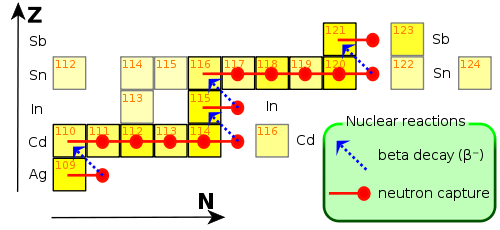11th Week: The s,r and p-Process
Production of elements heavier than iron
As the nuclear charge increases, the transmission probability decreases drastically. This in turn makes the charged cross sections to be very small and therefore at moderate stellar temperatures it is very difficult to form heavy elements. However, the elements heavier than are observed which requires explanation. Below we explain the main possible processes that might have occured in stellar nucleosynthesis.
Neutron capture
Neutron capture plays an important role in the cosmic nucleosynthesis of heavy elements. In stars, it can proceed in two ways - as a rapid process (an r-process) or a slow process (an s-process). By neutron capture, nuclei of masses greater than 56 can be formed that could not be formed by thermonuclear reactions, i.e., by nuclear fusion.
The S-process
The S-process or slow-neutron-capture-process is a nucleosynthesis process that occurs at relatively low neutron density and intermediate temperature conditions in stars. Under these conditions the rate of neutron capture by atomic nuclei is slow relative to the rate of radioactive beta-minus decay. A stable isotope captures another neutron; but a radioactive isotope decays to its stable daughter before the next neutron is captured. This process produces stable isotopes by moving along the valley of beta stability in the chart of isotopes. The S-process produces approximately half of the isotopes of the elements heavier than iron, and therefore plays an important role in the galactic chemical evolution.
The S-process is believed to occur mostly in Asymptotic Giant Branch stars. In contrast to the R-process which is believed to occur over time scales of seconds in explosive environments, the S-process is believed to occur over time scales of thousands of years. The extent to which the s-process moves up the elements in the chart of isotopes to higher mass numbers is essentially determined by the degree to which the star in question is able to produce neutrons, and by the amount of iron in the star's initial abundance distribution. Iron is the "starting material" for this neutron capture - beta-minus decay sequence of synthesizing new elements.
The main neutron source reactions are:
The R-process
The R-process is a rapid neutron capture nucleosynthesis process occurring in core-collapse supernovae responsible for the creation of approximately half of the neutron-rich atomic nuclei that are heavier than iron. This process together with S-process account for a majority of galactic chemical evolution of elements heavier than iron. The nuclear physics of the R-process is as follows.
Immediately after a core-collapse supernova, there is an extremely high neutron flux which is on the order of 10E22 neutrons per cm^2 per second and high temperature, so that neutron captures occur much faster than beta-minus decays far from stability, meaning that the R-process "runs up" along the neutron drip line. The only two hold-ups inhibiting this process of climbing the neutron drip line are a notable decrease in the neutron-capture cross section at nuclei with closed neutron shells, and the degree of nuclear stability in the heavy-isotope region, which terminates the R-process when such nuclei become readily unstable to spontaneous fission. After the neutron flux decreases, these highly unstable radioactive nuclei quickly decay to form stable, neutron-rich nuclei. So, while the S-process creates an abundance of stable nuclei with closed neutron shells, the r-process creates an abundance of nuclei about 10 atomic mass units below the S-process peaks, as the R-process nuclei decay back towards stability on a constant A line in the chart of nuclides.
Proton capture
The proton capture process is a nucleosynthesis process occurring in core-collapse supernovae responsible for the creation of some proton-rich atomic nuclei heavier than iron. There are two proton capture processes, namely p-process (photodisintegration) and rp-process (rapid proton capture which actually works by adding protons).
The P-process
The p-process occurs through the mechanism of photodisintegration, which occurs when a gamma-ray, or energetic photon, knocks particles out of an atomic nucleus. By examining the chart of nuclides, one can see that from hydrogen to calcium (1 < A < 40) stable nuclei have an approximately equal number of protons and neutrons. However, for increasingly heavier stable nuclei, more than one neutron is required for each proton because of Coulomb repulsion. The p-process is responsible for the nucleosynthesis of some atomic nuclei with more than 100 nucleons (A > 100), and so if one starts with a heavy, stable nucleus, removing neutrons will increase the proton ratio of the resulting nucleus. There are two important nuclear reactions which accomplish this task, neutron-photodisintegration and alpha-photodisintegration, written (,n) and (,α), respectively.
The temperature during a core-collapse supernova explosion reaches up to 2-3 GK. The resulting black-body radiation produces a photon bath that can disintegrate the seed nuclei created by the neutron capture processes. Under these conditions it is believed that photodisintegration reactions are responsible for the production of some proton-rich atomic nuclei with more than 100 nucleons (A > 100). It has been recently proposed that neutron star mergers, that is the collisions between two neutron stars in a binary star system will have similar conditions and may also play a role in the production of p-process nuclei, but this has yet to be observationally confirmed. Because the p-process operates for only a short time by knocking a few neutrons or alpha particles out of heavy nuclei synthesized through another route, p-process nuclei are less abundant than neighbouring isotopes. Therefore, the contribution of the p-process in creating atomic nuclei is very small.




